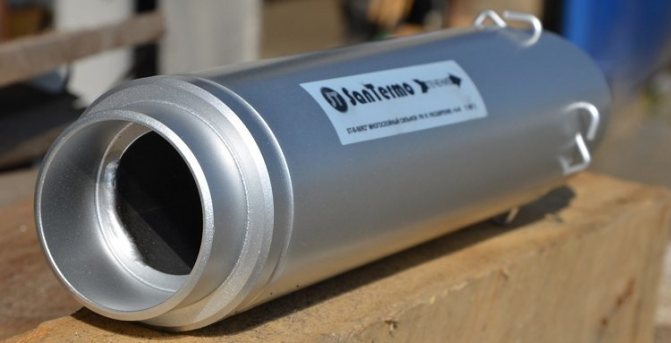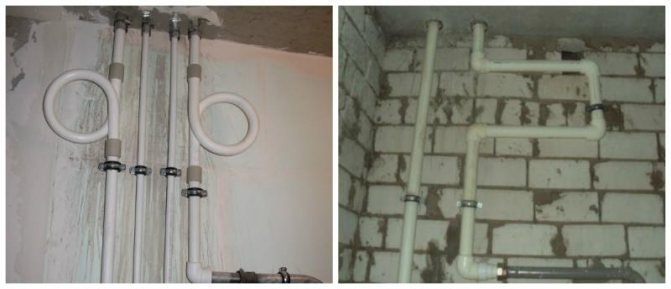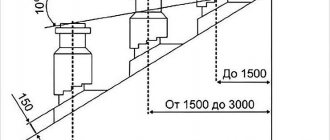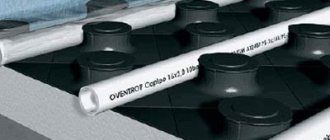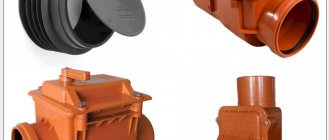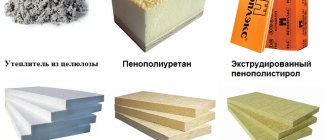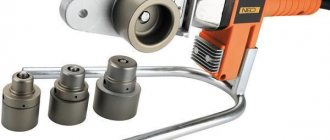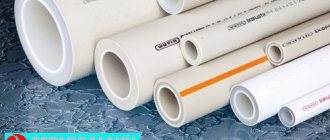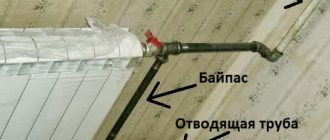What are expansion joints
For laying heating or a water supply network, polypropylene pipes are most often taken. They have proven themselves excellently because they have an impressive number of positive characteristics.
But, with such a number of quality indicators, they have a significant drawback - when exposed to heat, they increase and sag.

For these reasons, when designing a network with a length of more than 10 meters, flexible expansion joints are installed.
These are simple docking structures that are flexible and visually resemble a loop. But, they play a very important role.
Compensators for laying polypropylene heating networks compensate for the expansion of the pipeline with sharp increases in temperature and pressure.
As a rule, they do not cost much, and the simplicity of the structure makes it possible to easily put the device into the pipeline. This increases the reliability of the network and extends the duration of its use.
Calculation of the coefficient of linear expansion and installation of polypropylene pipes
Correctly positioned supports and well-executed piping will help solve the problem of thermal deformation. Ideally, you want to create a flexible system with a minimum number of rigid nodes. The coefficient of linear expansion of polypropylene pipes is taken into account when calculating the length of the deformable section, and the amount of elongation depends on the temperature of the working medium and on the type of material.
Linear expansion of polypropylene pipes
Compensation methods
Angle compensation method
When designing a heating and water supply system, the coefficient of thermal expansion of polypropylene pipes must be taken into account. And during installation, such conditions are created in the fastening zone so that the pipe can move freely in the range of deformation magnitude. This can be achieved in several ways:
- through the compensating capacity of the pipeline;
- installation of temperature compensators;
- correct placement of supports.
Linear expansion table for polypropylene pipes
An expansion joint is used between the rigidly fixed supports. It can be loop-shaped, P or L-shaped. Sometimes pipes are laid with a "snake". In a cold water system, linear expansion can be neglected. The fixed supports guide the extensions towards the elements.
U-shaped expansion joint for polypropylene pipes
When installing the heating system, a gap must be provided between the pipe and the wall.
When using fixed supports, the pipe will not be able to lengthen when the temperature rises. In movable mounts, the pipe can move longitudinally.
Locking feet allow axial extension and sliding mounts allow sliding.
Sliding support for linear expansion compensation
Supports with a strap are suitable for ceiling structures. The best solution in this case is plastic fasteners, they cannot violate the integrity of the pipe, they must be fixed at intervals equal to 20 pipe diameters.
- Filters and taps are fixed with fixed fasteners, while the fittings should not rest against the supports.
- The straight gasket is changed to a corner joint.
- The compensating sleeve has a length that will be sufficient to form a technological gap.
- Installation of polypropylene elements is carried out after calculations (SNiP 41-01-2003, SP 40-101-96). Incorrectly selected support distances lead to pipe deflections, and this creates additional load on the supports.
- When connecting pipes by welding, the foil is removed, which complicates installation. Fiberglass-reinforced pipes are devoid of this disadvantage. They are durable and do not require cleaning.
The compensation loop is the best way to avoid the negative effects of linear expansion
Kozlov compensator
A new development that prevents deformation and extends the life of heating and plumbing systems. The device consists of an external polypropylene casing and a two-layer stainless steel corrugation.
The connection is carried out with transition couplings. The product is suitable for reinforced and unreinforced polypropylene pipes.
Working pressure: 16 atmospheres, maximum temperature of the working environment: 100 ° C, maximum compensating compressive capacity: 25 mm.
The bellows expansion joint consists of a bellows and auxiliary fittings. It balances possible movements.
Deformation calculation
The coefficient of thermal expansion of reinforced polypropylene products (K lr) is 0.03-0.05 mm / mK. With an increase in temperature by 60 ° C, the elongation will be 2-3 mm (per meter).
Using the table, you can determine the expansion of a polypropylene pipe depending on its length and the temperature difference (medium and air).
In online mode, using special programs, you can also find the length of the deformation.
You can calculate the elongation of the pipe using the formula:
I = a * L * t,
where I is the value of longitudinal deformation in mm, a is the expansion coefficient depending on the pipe material,
t is the difference between the temperature of the coolant and the ambient temperature during installation work, L is the length of the pipe for which the amount of deformation is calculated.
Calculation example. We find out to what length the product will lengthen when installing a heating system 7 m long made of reinforced polypropylene (air temperature 24 ° C, operating temperature of the coolant 90 ° C):
I = 0.03 * 7 * (90-24) = 14 mm
Consequently, when the heating system is turned on, the communications will become 14 mm longer.
Consequences of incorrect installation:
- when the coolant is supplied to the system, the pipes are often deformed and "pull out" the fasteners;
- air is collected in the upper part of the pipeline, as a result of which its throughput decreases, due to a low pressure, the temperature of the working medium decreases;
- sometimes the deformation of the elements is so strong that the heating system is completely out of order.
When connecting pipes by welding, the foil is removed, which complicates installation. Similarly, fiberglass-reinforced pipes are devoid of a similar disadvantage. They are durable and do not require cleaning.
Plastic pipes are flexible; when deformed, they bend without being damaged. Polypropylene products are durable, do not require painting, do not need thermal insulation and do not rust.
They are easy to install and do not emit harmful substances.
But when designing a hot water supply or heating system, it is imperative to take into account the ability of plastic to expand with increasing temperature and use devices that absorb movements.
Thematic video
Video: types of expansion joints
Video: thermal expansion and contraction of pipes
Source: https://trubsovet.ru/material/plastik/koefficient-linejnogo-rasshireniya.html
How big is the need for these devices
Consider the question: "Do I need a compensator for polypropylene pipes" should be from such an angle that experts recommend putting them on a mandatory basis.
And they motivate it with the following reasons:
- Normalized operating pressure in the line throughout the entire period of use.
- Maintaining straightness along the entire length of the network.
- Convenient planning and laying of the pipeline.
- Small size.
IMPORTANT! Experts unanimously say that these adapters are very important. Otherwise, the laid heating pipeline made of PP blanks will not last a long time. Heat deformation will damage it.


In what cases are compensators used?
In essence, expansion joints are a flexible piece of polypropylene pipe wrapped in a loop, which is designed to partially compensate for the thermal load during expansion of the pipe and take part of the load when the pressure inside the pipe increases. Consequently, expansion joints for plastic pipes can significantly extend the life of the plumbing wiring in the house and make its functioning better.
There is a whole list of types of factory-made expansion joints on sale, however, often such elements can be made independently, which will be much cheaper. The main thing in this case is to adhere to the technology of assembling the product.
The main objects where the use of polypropylene pipe expansion joints is appropriate are:
- plumbing;
- sewer system;
- central or individual heating.
However, not only in a private house, installation of additional devices may be required. A loop-shaped expansion joint for polypropylene pipes may also be required in industrial or public premises, where it is mounted between straight sections of heating pipes.
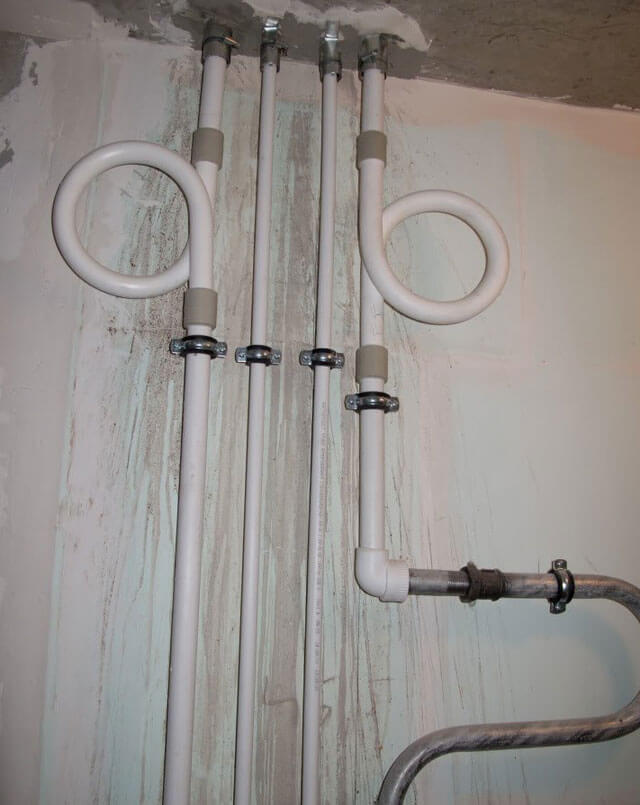

Thanks to such compensation, the load can be achieved:
- growth of the useful life of pipelines;
- extinguishing vortex flows in pipes;
- maintaining the tightness of the line under conditions of increased load;
- normalizing the pressure indicators in the pipeline;
- minimizing the degree of linear expansion of hot water pipes.
It should be noted that the loop-type expansion joint can be mounted on both horizontal and vertically placed pipes, and is suitable for any lines transporting liquids.
How to choose a device correctly
To find out which compensating element is best installed on polypropylene, you need to understand in detail the device of these devices.
Polypropylene (PP) piping is installed very often. With its help, they equip the supply of hot water, where the temperature rises to almost a hundred degrees. During use, polypropylene has shown a number of characteristics, thanks to which it is ideal for plumbing systems and heating. It is not afraid of the influence of aggressive chemical environment, has a low weight and is quite durable.
But, despite all the advantages, polypropylene also has a significant drawback. As the temperature rises, the linear expansion capacity of polypropylene increases markedly. The system then begins to sag.
For this reason, it is recommended to install flexible expansion joints in areas with a length of more than ten meters. They make it possible to reduce thermal expansion.
To select and install it correctly, you must take into account the diameter. It must match the diameter of the pipeline itself. Most often, the diameter that the expansion element has is from 20 to 40 mm. For a house and apartment, a 20 millimeter device will be enough.
As for the manufacturer, it is better to give preference to well-known world brands. They represent high quality goods for polypropylene nets, which are successfully used in many areas.
Bellows expansion joint for polypropylene pipes
A bellows expansion joint for polypropylene pipes is a shock absorbing and compensating element for mechanical or thermal changes in a polypropylene piping system.
Working stroke: 70mm (55mm for compression and 15mm for tension) Bellows: multilayer bellows and inner shield are made of stainless steel 08X10H11T.
Application area:
- Heating pipes of tall buildings
- Hot and cold water supply systems
- Vertical pipe connections.
Design features of the expansion joint for polypropylene pipes
The polypropylene bellows expansion joint is manufactured in the "EJMA" version and meets the temperature and pressure standards according to DIN 2401. The external shield of the expansion joint is made of aluminum.
The nominal pipe diameter for this expansion joint can be from 15mm (1/2 ") to 50mm (2"). The working pressure must not exceed 16 bar. The temperature range within which normal operation of the compensator for polypropylene pipes is possible is + 100 ° С. This compensator is designed for 1000 complete cycles.
Specifications and prices
The table below shows the technical specifications for bellows expansion joints for polypropylene pipes, the price is indicated in dollars.
| Connection diameter. | Dn, mm. | D1, mm. | D2, mm. | L, mm. | L1, mm. | Price, $ |
| 1/2” | 15 | 38 | 35 | 390 | 15 | 33,00 |
| 3/4” | 20 | 38 | 35 | 390 | 15 | 33,00 |
| 1” | 25 | 48 | 44 | 440 | 15 | 52,00 |
| 1 1/4” | 32 | 60 | 54 | 490 | 20 | 65,50 |
| 1 1/2” | 40 | 75 | 69 | 470 | 20 | 85,50 |
| 2” | 50 | 75 | 69 | 470 | 20 | 87,50 |
Varieties
In practice, the following varieties have shown themselves best:
- Bellows expansion joints for polypropylene (PPR). They are used when installing a heating and water supply network made of PPR materials. The conventional diameter of the bellows types is from 1.5 to 5 cm. The type of connection of bellows varieties is a sleeve, and the casing is made of aluminum. The inner screen is made of stainless steel. Working medium temperature up to one hundred and fifteen degrees, pressure up to 16 bar. The working medium for the bellows version is drinking water, air, steam.
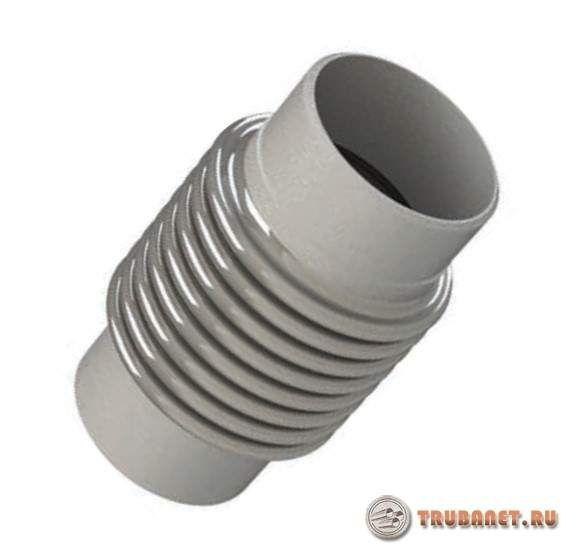

- Shear. They are designed to compensate for movement in two directions. Design features in this situation are one or two bellows corrugations. It is made of stainless steel and fastened with fittings-connectors.


- Swivel They are used to level the linear increase in the area of turn of the highway and are used to fix the turn. Most often they are taken to change the direction of the system by ninety degrees.
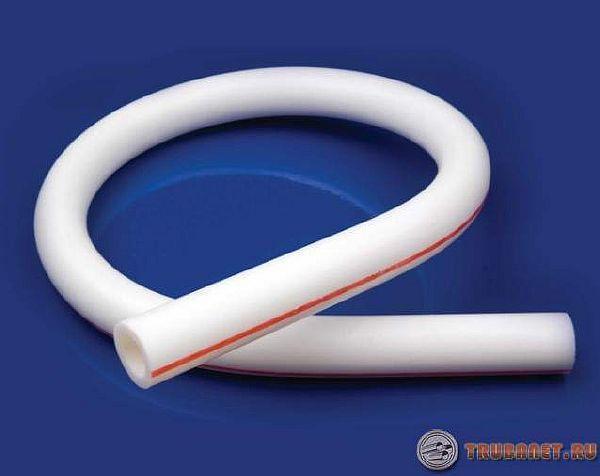

- Universal. They are endowed with three options for working strokes. They are placed where it is necessary to lay a short network, or in a place limited for installing a bellows type.
- Flanged. These rubber parts are installed in such a place where there is a need to dampen the shock wave from a sharp increase in the average working pressure. They also smooth out the axial inaccuracies of the pipeline.
- Loop-shaped device.

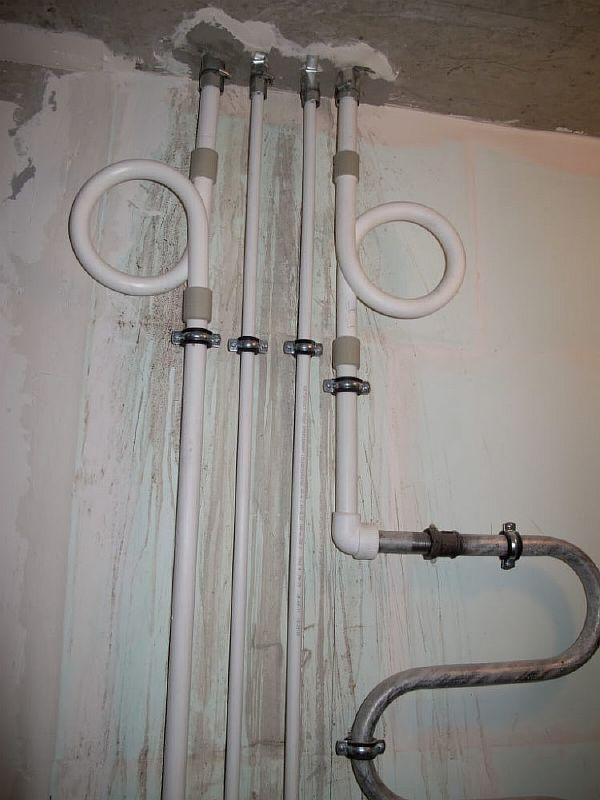
- Serpentines
- Axial bellows mechanisms

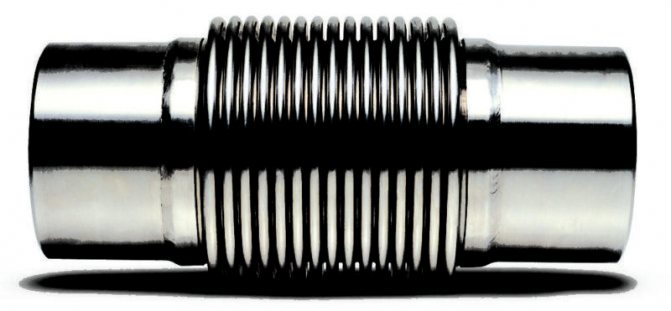
- Flanged devices made of soft material
- Bellows

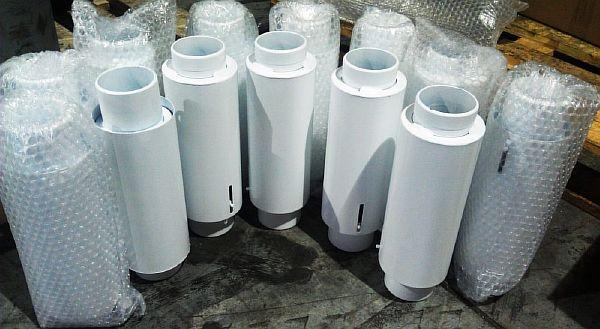
- Versatile, effective for axial, angular and lateral displacement. They are recommended for installation on a small branch of a highway that has branches.
Manufacturers offer a variety of devices that are of excellent quality. But, the self-made compensation loop in the heating system also does an excellent job with the functions assigned to it.
It is not difficult to make such a device with your own hands. The compensation loop can be made in a short time. This important detail, fastened correctly, becomes a guarantee of the flawless operation of heating or hot water supply.
Simple self-made equipping with a compensation loop will increase the working resource of communication networks up to half a century.


When expansion joints are needed
Since polypropylene has a high coefficient of thermal expansion, pipes from it must be equipped with protective devices. Compensators are installed:
- on the water supply;
- when installing underfloor heating;
- on the sewer;
- in heating and hot water supply systems.
The devices are installed on horizontal and vertical pipes in residential buildings, industrial and administrative buildings. Their application provides:
- long trouble-free service life of the pipeline;
- damping eddies;
- stability of pressure in pipes during its surges;
- protection against water hammer;
- no distortion during thermal expansion.
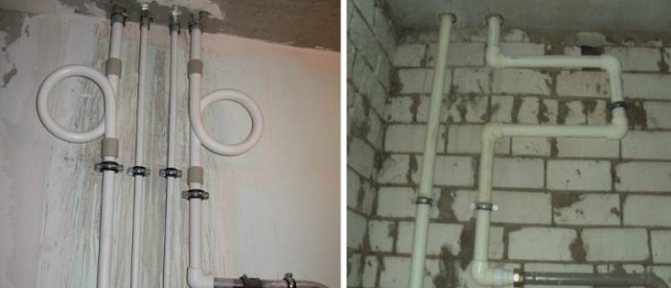

Which option is better to install on polypropylene
When tested in practice, all of the listed devices give the expected result. T-shaped devices, bellows, and others show high efficiency. This manifests itself in the same way in all water supply and heating systems.
Technical analysis confirms that expansion joints on polypropylene heating pipes work flawlessly, only they are recommended for use in flexible polypropylene structures.
Before installing the expansion joint on a polypropylene pipe, the following calculation must be made. It is necessary to calculate the load, pressure and compare the diagrams of each wiring and heating risers.
At the same time, it will be clear where it is necessary to put additional nodes - compensating devices. When calculating expansion joints for PP mains, it is necessary to take into account many indicators, including the cross-section of the pipe assortment, the diameter inside and outside, the types of bends, heating risers, and the type of installed and already standing mechanisms.
Types of compensation devices
In practice, several main types of expansion joints for polypropylene pipes are actively used:
- In the form of a loop - it is the simplest.
- Serpentine or spiral.
- Bellow axial with marking KSO or surge arrester.
- Flanged type - allows to mitigate water hammer, made of soft material and easy to install.
- Bellows expansion joint for polypropylene pipes is a node device for restraining linear expansion.
- Shear - allows you to restrain linear expansion in 2 planes. Consists of two pieces of stainless steel corrugated pipe, connected with a special fastener.
- Swivel - used wherever the pipe bends at an angle of 90º.
- Universal - suitable for compensating for shifts in a cross, angular or axial section, especially on small sections of branched pipelines where other types of devices are not applicable.
All these devices are united by the fact that in order to obtain the desired effect, they must be mounted only on sections of flexible polypropylene pipeline.
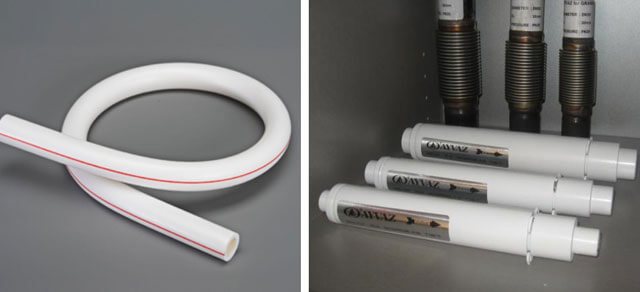

It is very convenient to use expansion joints during installation of turning sections. Thanks to these devices, it is possible to extinguish fluid turbulence and stabilize the pressure in the pipeline.
It is worth noting that pipelines for transporting hot water, with proper installation of compensating devices, can last 50 years longer, while remaining completely sealed.
Among the best foreign manufacturers of expansion joints for polypropylene pipes are Finnish companies, as well as the Turkish company Kayse. Among the domestic suppliers, the company SanTermo can be noted.
Mounting features
The main methods of fastening in this case are:
- welded;
- flanged.
In order to correctly mount the compensation device, you need to know that most types of these devices require rigid fixation using welding.
Before installing an expansion joint for polypropylene heating pipes, it is necessary to check the coincidence of the diameter of the pipe product and the element to be installed. This is the only way to make a heating structure with high tightness.
It is better to assign the installation of a flange joint to professional craftsmen. For such a joint, the installation of a counter flange will be required. This allows you to create a split joint, which is very convenient when carrying out repair work on the heating or water supply pipeline.
The bellows mechanism is placed on a linear short section of the line, and works great for a room where temperature drops of the coolant often occur.
Important! Before starting installation work, it is recommended to check the installed part for damage.If any are found, this device cannot be installed.
Installation of expansion joints for PP pipes
Before proceeding with the installation, we advise you to familiarize yourself with the basic rules and requirements. Here they are.
- Before welding, professionals wrap technical units with asbestos cloth in order to prevent the ingress of metal splashes.
- The compensator is installed exclusively on straight sections of the highway.
- Only one technical unit can be installed between a pair of fixed fasteners.
- Also, before installation, it is checked whether the technical parameters of the compensator correspond to those of the pipeline.
- Finally, the expansion joint should be checked in advance for defects and damage. If the product is defective, then it cannot be used.
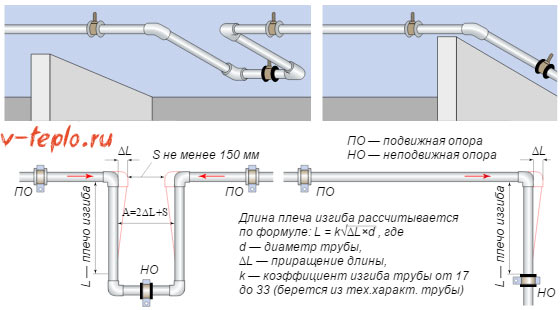

U- and L-shaped expansion joints for polypropylene pipes
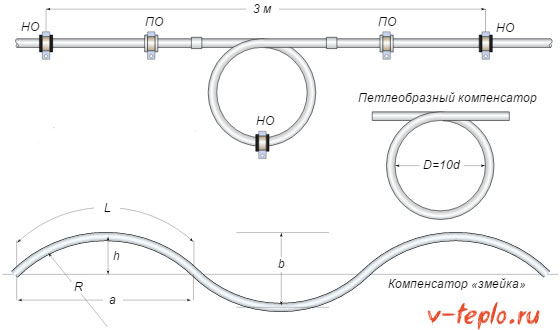

Compensators: loop and snake
| Temperature difference, ° С | The ratio of the length of the arc to the length of the chord, L / a | Arc length, L | Chord length, a | Arrow deflection, h |
| 10 | 1,0022 | 0,2269 | 0,2264 | 0,0064 |
| 20 | 1,0045 | 0,3316 | 0,3301 | 0,0137 |
| 30 | 1,0067 | 0,4014 | 0,3987 | 0,0201 |
| 40 | 1,0087 | 0,4538 | 0,4499 | 0,0256 |
| 50 | 1,011 | 0,5236 | 0,5176 | 0,0341 |
| 60 | 1,0131 | 0,5585 | 0,5513 | 0,0387 |
| 70 | 1,0168 | 0,6109 | 0,6014 | 0,0463 |
| 80 | 1,0176 | 0,6458 | 0,6346 | 0,0517 |
| 90 | 1,0196 | 0,6807 | 0,6676 | 0,0574 |
| 100 | 1,022 | 0,7156 | 0,7004 | 0,0633 |
Table Values of geometric parameters of the "snake" compensator with the pipe diameter taken as a unit


The installation technology itself depends on which type of expansion joint was chosen. Tellingly, the threaded method of mounting the device in a polypropylene pipeline does not provide high strength of the system as a whole. And this is its main drawback. And in order for the strength to be at the required level, it is recommended to resort to welding.
Note! Another method of installation is very popular - the so-called "American". It consists in the use of a detachable fitting, on the one hand equipped with an iron thread, and on the other with a polypropylene base.
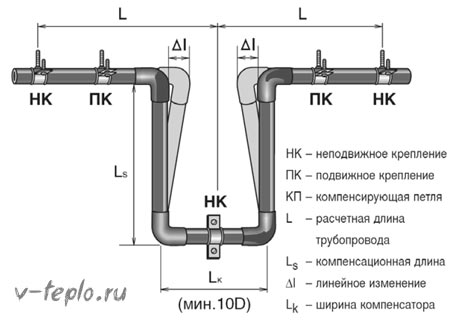

The welding procedure itself for attaching the expansion joint to the pipes consists of several stages.
- Stage one. Preparatory activities.
- Stage two. Layout of the entire highway.
- Stage three. Cutting the pipeline.
- Stage four. Actually, welding of products.
So, welding is the most effective method of fastening, for which, as noted above, a special soldering iron is required. First, the section of the expansion joint that will enter the pipe is thoroughly cleaned. After that, the pipe and the adjoining part of the technical unit are heated using a welding machine, then connected.
For the cooling period, both elements must be securely fixed, otherwise the connection will not be airtight and will leak during use.
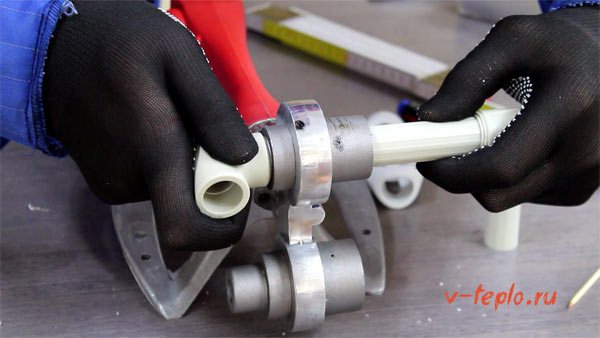

And if expansion joints for polypropylene pipes are installed using a combined method (with a metal water supply system), then the connection should be made somewhat differently - using not only welding, but also threads. It happens in the following way. At first, the risers are turned off, and the water is drained from the system. Then the valves are removed, and the pipes are cleaned with a cable. Only after this is the combined option installed. The plastic component is welded to the pipeline, and the metal component is threaded to the mixer.
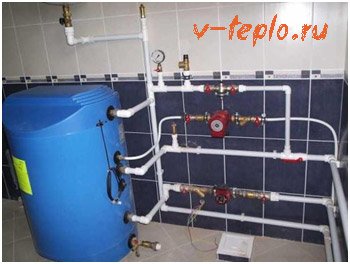

Installation of heating from polypropylene pipes
We advise you to familiarize yourself with our installation guide for a heating system made of polypropylene pipes. See all details here
How the calculation is performed
The calculation of expansion joints for polypropylene pipes is not difficult to perform, but in such a situation you will need to understand the principle of their operation and know their varieties.
There are certain norms according to which the calculation of sliding, fixed mountings is carried out. At any point between the fixed supports, one such mechanism (at least) must be inserted.


To determine their exact number, it is recommended to draw an exact plan of the pipeline and mark all fixed fixtures. It is so easy to calculate the required quantity for each section of the highway.


When calculating, use the following formula: Q = L / ΔLk.In it, the first indicator is the required number of compensating elements, L is the length of the section. ΔLk is the value of the compensating possibilities, it is expressed in millimeters.
Detailed information for the calculation can be obtained from the manufacturers of pipe-rolling assortment.
Determination of places for the rational placement of supports
In order to predict the behavior and degree of change in the linear dimensions of the pipes when the temperature of the carrier changes, the points of the proposed location of fixed and sliding supports are marked on the pipeline plan. For each section of the pipeline located between the fixed supports, the maximum compensating capacity of all its elements is calculated.
If the calculated temperature play of the linear dimensions of the pipeline exceeds the limit value of the permissible deformation, an expansion joint must be installed in this section. "ST-B-PL". The most efficient operation of such devices is achieved when they are placed in the middle - at the same distance from the fixed supports of the pipeline.
How to calculate the right size
The dimensions of the expansion joint for polypropylene pipes can be calculated based on an example. For example, a blank is taken, which has a size of 90 mm.
It will expand by 4.2 cm and contract by 2.1 cm. Accounting is carried out for the largest increase, ΔL / 2 = 21 mm.
It is necessary to draw a horizontal line from the vertical section to the intersection with the gradient line of 9 cm of the workpiece. Then it is necessary to lower the perpendicular from the intersection to a horizontally placed scale.
The resulting value will show the knee free size for the loop mechanism. Based on this, the compensator 12 cm long and 6 cm wide will allow free movement with an amplitude of 2.1 cm. Therefore, the product will be able to freely contract and expand.
It is recommended to calculate the distance between expansion joints during the laying of polypropylene pipes with a margin.
At the same time, it is necessary to calculate that this distance must be selected based on the fact that the reinforced product expands by 1 mm for each running meter, and not reinforced by 3 mm.


The exact elongation values for each product depend on temperature changes, volume and grade, as well as the manufacturer. They must be checked on the manufacturers' websites.
П - shaped elements
High-parameter steam lines are designed in such a way that thermal deformation is leveled out due to the natural configuration of the pipeline.
In places where this cannot be achieved, U-shaped elements are placed. They come in three options, which are distinguished by the ratio of the shoulder length and straight inserts.
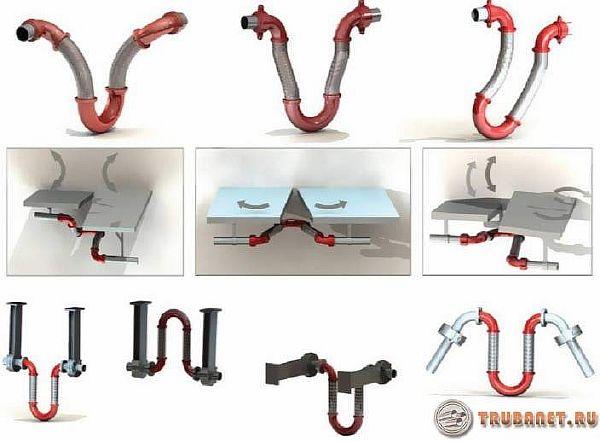

A U-shaped compensator for polypropylene pipes, just like analogues of another type, needs to calculate the dimensions necessary to compensate for the thermal change in the line.
For precise definitions, you can use the proposed online forms. It is very convenient to perform all calculations on them.
The calculation of the u-shaped compensator for polypropylene pipes is made taking into account the following recommendations:
- I advise you to take the highest stress level in the backs in the range from 80 to 110 MPa.
- The optimal ratio of the overhang of the element to the outer volume of the workpiece should be taken as follows - Н / Dн = (10-40). With this calculation, an element overhang of 10 DN corresponds to a DN 350 pipe line. And an overhang of DN 40 corresponds to a DN 15 pipe.
- The optimal indicator of the width of the p-shaped joint for its overhang is advised to be taken within L / H = (1-1.5).
- If a very large version is required for installation, then it can be replaced with two smaller structures.
- When calculating the thermal increase in the line, the temperature of the heat carrier is taken into account the highest, and the environment - the lowest.
When performing calculations of the u-shaped form, it is necessary to take into account the following parameters:
- The pipe is filled with liquid or vapor.
- What material is the pipe made of (metal, plastic).
- The highest ambient temperature is not more than 200 degrees Celsius.
- The network pressure must not exceed 16 bar.
- The structure stands on a horizontal highway.
- The joint is symmetrical and the shoulders are the same size.
- Immovable supports must be very rigid.
- The line is not exposed to wind and other load influences.
- Friction resistance of movable supports during deformation is not taken into account.
- The bends are smooth.
It is recommended to put U-shaped mechanisms on straight extended zones.
Watch the video
The absence of U-shaped devices on a rigidly reinforced line with different temperatures of the medium leads to stresses that lead to deformation and destroy the pipeline.
Kozlov mechanism
Kozlov's compensator for polypropylene pipes is an excellent option for heating and plumbing.
Watch the video
This mechanism is intended for leveling the thermal increase of reinforced and non-reinforced PP pipe-rolling materials in the hot water supply and heating system.
Kozlov's design works exactly like other similar devices. But, at the same time, it has some design differences.
The Kozlov connection takes up little space and has a presentable appearance. It fits harmoniously into the system.
Some technical indicators of this mechanism:
- The ability to compensate for the compression of a polypropylene article of 2 cm for a volume of 2.5 cm and 2.5 cm for a volume of 3.2.
- Working pressure level - 16 atm.
- The highest operating temperature is 100 degrees.
Installation on risers
Before installing these parts on plastic risers, and straight sections of the highway, you need to process the technical units with asbestos cloth. So the structure will be protected from metal splashes.
Only one technical unit is allowed to be placed between two fixed fasteners.
Putting this device on a riser or a straight section, you need to check the coincidence of the fastened elements. The threaded version of the device on polypropylene systems does not guarantee high strength, therefore, welding is recommended.
Also in great demand is such a device as the "American". This detachable fitting has a metal thread on one side and a polypropylene base on the other.
How such structures are installed
Video
Installation and installation of expansion joints on polypropylene pipes must be carried out in accordance with the main requirements and standards:
- Before the start of the welding activities, the craftsmen wrap the technical units with asbestos cloth. This is done to prevent splashes of metal.
- Installation may only be carried out in a direct network area.
- Between two immovable fasteners, only one technical unit is allowed.
- Before carrying out work, it is necessary to check whether the technical parameters of the element match the data of the pipe network.
- And most importantly, this connection must be inspected for defects and damage before installation. In the event of any defect found, such a product cannot be taken into work.
Installation will depend on the type of product you choose. The threaded method in operations with polypropylene products does not provide the required high strength.
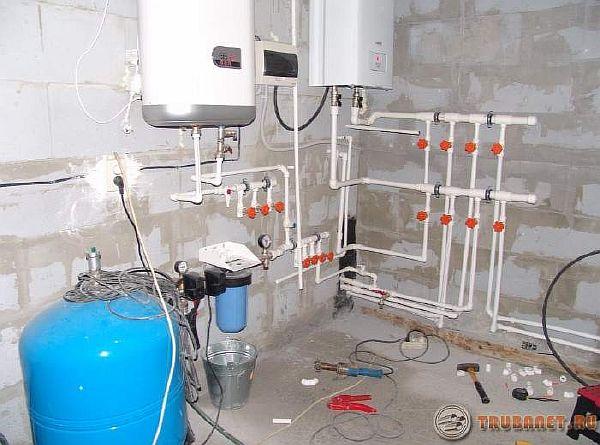

To achieve this strength, welding works are used. They are considered to be the most efficient and reliable fastener. A welding machine is used for them.
Watch the video
IMPORTANT! Such type as "American" is very popular during installation. The essence of this method is to use a detachable fitting. It has a metal thread from one entrance, and from the return entrance it was equipped with a PPR base.
If the installation is carried out in a combined way, then the joint is performed using welding on one side, and on the other - a threaded form of the joint.
The installation of expansion joints on polypropylene pipes has some peculiarities. Professional craftsmen will highlight several types of fastening.
- Welded.
- Flanged.
During welding operations, the structure is fixed “tightly”. During installation, the end of the workpiece is soldered with a compensation. For high tightness, the seams during operation must completely match.
In the case of flanged fasteners, the part is fixed not on the pipe, but on the counter flange. Thanks to this, a split joint is obtained, which makes it easy to change the required technical unit in the event of a leak.
Video
Such installation can only be performed by highly qualified specialists, because it is rather difficult to work with.
Tables used for compensating devices
The table for installing compensating mechanisms on polypropylene pipes for each type of device is different. For example, for a loop-shaped device, it is like this:
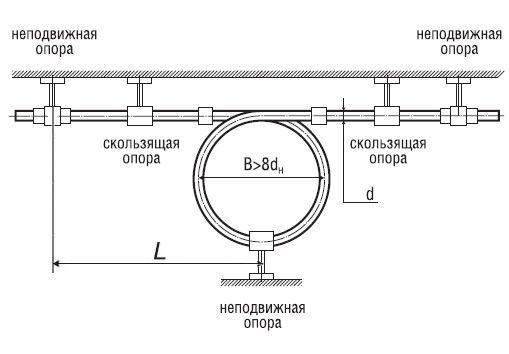

And then you can see the table that is used for bellows devices.
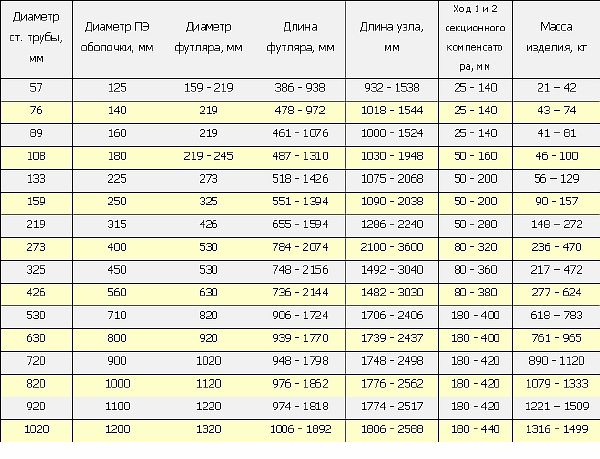

The calculated length of the compensation is taken as the distance at which there are no suspensions and supports that impede the compensatory movement. The spacing between the supports is set in accordance with the ambient temperature and the pipe diameter.
If difficulties arise in the calculation, and an inexperienced master has them most quickly, then it is better to ask for help from professionals. An experienced craftsman can provide assistance not only in choosing the right one for a particular situation, but can also quickly install the device. The finances spent on his services will guarantee the reliable operation of the heating system in the house.
Their purpose
The role of compensating devices in polypropylene heating pipes is enormous. Many people mistakenly believe that this detail is not so important. But, this opinion is fundamentally wrong. If the line constantly shrinks or lengthens freely, then additional stress arises in its walls.
Consequently, thermal expansion poses a serious threat to the integrity of the entire structure. As a result of its action, the service life of the polypropylene (PP) pipeline is significantly reduced. If you do not provide for any measures to smooth out the ramp, then the line will quickly fail. What an economical owner will never allow.
Self-compensation and compensation through the use of an elastic element can be distinguished from the methods of combating the effect of change from temperature influence. Additional countermeasures include installing the required number of supports to eliminate sagging.
Polypropylene, due to its flexibility, allows for protective compensation. The most effective is the compensation option, when the bending of the highways is performed perpendicular to the direction of the route. In this direction, a free compensation length is left, which prevents additional stress and pressure build-up.
Separately, it is necessary to dwell on the importance of deformation smoothing. This method is based on the use of the cushioning capabilities of the material itself, this includes all types of polypropylene: PP, PPRC and others. Deformation smoothing by means of compensating parts has become widespread due to its low cost.
These parts take on the mechanical load, and at the same time the section of the line and the fasteners are unloaded. After the influencing factors cease to act, due to the elasticity of the compensating mechanism, the network returns to its original state.
Summing up, we can conclude that which of the options to choose: simple in the form of a loop, Kozlov's device, or bellows, everyone will make a decision independently.But, one thing is clear for sure, you cannot do without this device.
Any economical owner who cares about the comfort of his home will make his choice in favor of the presence of these mechanisms. This simple and inexpensive device will save a lot of money in the future, which will have to be spent on replacing a broken line.
Thermal expansion compensation methods
There are two main ways of dealing with the effect of thermal expansion of polypropylene pipes (which ones to use for plumbing in an apartment, find out here) and its negative consequences:
- self-compensation;
- compensation using elastic elements from other materials.
Additional methods of dealing with thermal expansion include the installation of the number of supports required to eliminate pipe sagging.
Smoothing thermal deformations
The method is based on the use of the amortization properties of the material itself, pipe sections, fittings.
A positive effect is achieved, due to the elastic deformation of individual sections at temperature elongation of the line.
Examples of devices using this method:
- L-shaped,
- U-shaped,
- ring expansion joints,
- snake-shaped devices.
When lengthening the main section of the highway there is a deflection of the shoulder of the compensator (for example, for U-shaped devices) or elastic deformation of the entire body of the compensator (for ring-shaped devices or compensators in the form of a snake).
They take on mechanical loads, relieving the pipeline section and the connection devices.
After the cessation of the factorscausing the expansion of the pipe, due to the elasticity of the material of the expansion joints, the system returns to its original position.
The method is quite widespread due to the low cost of expansion joints and their ease of use.
The installation of devices is carried out by the same means (see the photo of the FUM tape here) as the assembly of the pipeline.
Expansion damping due to elastic properties of other materials
This method is most widespread.
This was influenced by the simplicity of manufacture, not complicated installation (how to properly wind sanitary linen, read here) and the use of devices, their high efficiency and small dimensions.
Most expansion joints used on polypropylene pipes, such as bellows, implement this principle.
Installation features
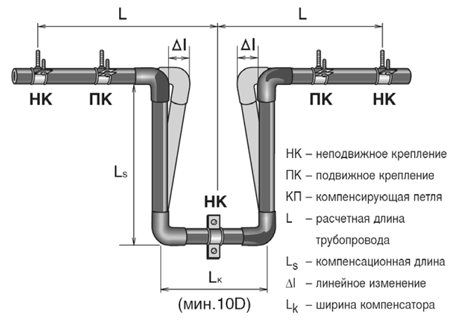

Installation of pipes with a compensator
When installing bellows expansion joints, you need to know the features of their installation:
- Install such a technical element only in a straight section.
- Before installation, it is important to carry out the correct calculation of the linear expansion and select the appropriate type of device.
- Before fixing, it is necessary to check the compliance of the technical characteristics of the used propylene pipes and expansion joints. They should be laid down in the pipeline design.
- It is advisable to check this technical unit for damage immediately before work. Defective models are immediately put aside.
- Only one expansion joint may be installed between two fixed mountings.
- Experienced craftsmen wrap the technical unit with asbestos cloth before welding. It will prevent the ingress of metal splashes on the expansion joint during welding.

